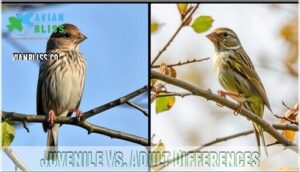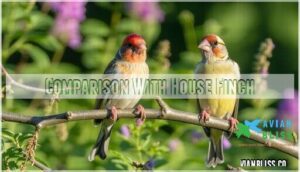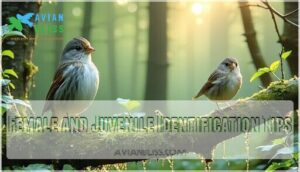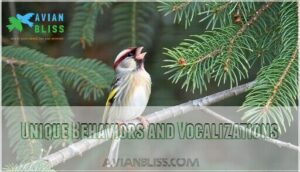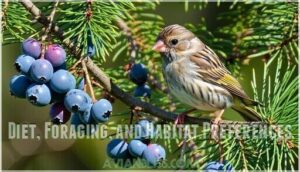This site is supported by our readers. We may earn a commission, at no cost to you, if you purchase through links.
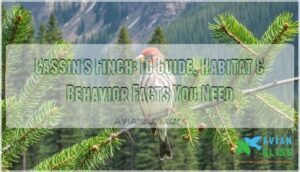
Males sport a bright red crown and breast with brown-streaked backs, while females show subtle brown streaking throughout.
Their distinctly curved bill sets them apart from house and purple finches—it’s perfectly designed for cracking open tough conifer seeds.
These mountain dwellers move with the seasons, following food sources up and down elevations rather than migrating long distances.
Their sweet, warbling songs often include mimicked phrases from other birds.
Understanding their habitat preferences and unique bill shape makes identification straightforward once you know what to look for.
Table Of Contents
- Key Takeaways
- Cassin’s Finch Identification and Physical Traits
- How Cassin’s Finch Differs From Similar Species
- Unique Behaviors and Vocalizations
- Diet, Foraging, and Habitat Preferences
- Migration, Breeding, and Population Threats
- Frequently Asked Questions (FAQs)
- What is a Cassin’s Finch?
- Where do Cassin’s Finch live?
- What is a Cassin’s finch (Haemorhous cassinii)?
- What does a Cassin’s Finch look like?
- What is the difference between a house finch and a Cassin’s Finch?
- What is the difference between a Cassin’s Finch and a purple finch?
- Where are Cassin finches found?
- Why is Cassin’s finch endangered?
- What is the difference between Cassin’s and House Finches?
- Do Cassin’s finches migrate?
- Conclusion
Key Takeaways
- You’ll easily identify male Cassin’s finches by their bright red crown that contrasts with their rosy-pink body and peaked head shape – they’re distinct from house and purple finches.
- You’ll find these birds in western mountain conifer forests above 4,000 feet, where their curved bills perfectly crack tough pine and fir seeds.
- You’ll hear their sweet, warbling songs that often include mimicked phrases from other birds – listen for their distinctive "kee-up" flight call.
- You’ll notice they don’t migrate long distances but instead move up and down mountains seasonally, following food sources and weather patterns.
Cassin’s Finch Identification and Physical Traits
You’ll recognize Cassin’s Finch by its peaked crown and the male’s bright red cap that contrasts sharply with its pinkish face and streaked flanks.
Look for that distinctive bright red crown – it’s like spotting a crimson cap in the canopy.
The species shows clear sexual dimorphism, with females displaying crisp brown streaking on white underparts while males develop their distinctive rosy coloration over two years.
Plumage and Coloration
Spotting a Cassin’s Finch means looking for that distinctive bright red crown color that sets males apart like a crimson cap.
Male plumage features rosy-pink bodies with fine streaking on flanks, while females sport crisp brown feather patterns with white underparts.
The red plumage appears less purple than similar species, creating a raspberry-like wash across the chest and back.
Bill, Head, and Tail Features
When identifying Cassin’s Finches, you’ll notice their distinctive bill shape sets them apart from their rose finch cousins.
These features make field identification much easier:
- Bill Size: Longer and more pointed than Purple or House Finches
- Head Shape: Peaked crown creates angular silhouette
- Tail Features: Short, deeply notched tail with fine streaking
The whitish eye ring and facial patterns help distinguish females from similar species.
Size and Sexual Dimorphism
You’ll notice male Cassin’s finches measure 5.7-6.1 inches and weigh around 0.6 ounces, making them heftier than house finches.
Sexual dimorphism creates striking differences—adult males showcase rosy-pink plumage with reddish-orange crowns, while females display gray-brown coloration with heavy streaking.
These size comparisons and dimorphic traits make field identification straightforward once you understand the distinct color patterns between sexes.
Juvenile Vs. Adult Differences
Young Cassin’s Finches present a puzzle for birders since maturity stages unfold gradually. Second-year males retain female-like plumage while singing like adults, creating fascinating color variation during their feather growth phase.
Key Juvenile vs. Adult Differences:
- Male Plumage Changes – Young males look streaky brown for a full year before developing that signature rosy-pink crown
- Beak Development – Juveniles show duller bill coloration that brightens as they mature into breeding condition
- Cassins Finch Characteristics – Adults display crisp contrast between red and brown areas while juveniles appear more blended
- Female Consistency – Adult females maintain their streaked brown appearance throughout life, making age determination tricky
Understanding bird identification using physical features is essential for distinguishing between juvenile and adult Cassin’s Finches.
How Cassin’s Finch Differs From Similar Species
You’ll often spot Cassin’s Finches alongside House and Purple Finches, but key differences help separate these look-alikes in the field.
Learning the subtle distinctions in bill shape, crown patterns, and streaking will save you from many identification headaches.
Comparison With House Finch
House Finch males sport orange-red coloration with heavy streaking, while Cassin’s Finch males show raspberry-red crowns with cleaner underparts.
Bill structure differs substantially – House Finch has a shorter, curved beak versus Cassin’s longer, straighter bill.
Head size appears rounder in House Finch compared to Cassin’s peaked crown. Tail length and feather color patterns help distinguish these finch species during identification.
Comparison With Purple Finch
Purple Finch creates confusion for birders, but Plumage Differences tell the story. Cassin’s Finch displays a sharper red crown contrasting with paler back, while Purple Finch shows uniform raspberry coloration.
Beak Shape varies dramatically between species.
- Color Variation: Cassin’s concentrated crown red vs Purple’s diffused raspberry hues
- Finch Size: Cassin’s appears sleeker with longer tail and wing projection
- Species Distinction: Cassin’s undertail coverts show fine streaks, Purple’s are white
- Finch comparison: Cassin’s eye ring is prominent, Purple’s barely visible
- Bird species: Bill length differs – Cassin’s straighter, Purple’s curved and chunky
Understanding the key characteristics of finch species comparison is essential for accurate identification.
Female and Juvenile Identification Tips
Identifying female and juvenile Cassin’s finches requires attention to subtle plumage patterns and beak shapes.
Females show cleaner white breasts with crisp streaking, while their brown ear patches create less contrast than Purple Finches.
Young males retain female-like appearance for a full year despite singing like adults.
| Feature | Female Cassin’s | Juvenile Male |
|---|---|---|
| Breast Pattern | Clean white with fine streaks | White with brown streaking |
| Facial Contrast | Subtle brown ear patch | Similar to female |
| Color Variations | Gray-brown upperparts | Brown with faint pink wash |
| Behavior | Silent foraging | Practices adult song |
These sexing techniques help distinguish them from House Finch females, which show dingier body stripes and less defined facial patterns.
Unique Behaviors and Vocalizations
You’ll discover that Cassin’s finches possess one of the most distinctive flight calls among North American finches – a sharp "kee-up" or "tee-dee-yip" that experienced birders rely on for instant identification.
These talented vocalists are also excellent mimics who incorporate songs from other species into their bubbly warbles, making each male’s performance unique.
Song and Call Characteristics
Cassin’s finch produces distinctive bubbly warbles that’ll help you identify this songbird in the field.
Their courtship songs feature clear, melodious phrases lasting 2-4 seconds with varied pitch changes.
- Song patterns: Rich trills mixed with buzzy notes in 4-7 phrase segments
- Call types: Sharp "pik" contact calls and soft "whit" foraging sounds
- Flight calls: Distinctive "kee-up" or "widee-ooli" separates them from purple finch song
Understanding bird songs basics is essential for accurate identification of Cassin’s finch vocalizations.
Mimicry and Communication
You’ll discover these talented vocal artists are exceptional mimics, copying everything from woodpecker calls to hawk screams with remarkable precision.
Their vocal learning abilities shine during breeding season when males incorporate borrowed sounds into elaborate courtship songs.
These social signals help establish territory and attract mates, with call variations revealing individual identity and flock communication patterns, showcasing their ability to mimic with remarkable precision.
Courtship and Social Behavior
During breeding season, you’ll observe bachelor flocks of second-year males who haven’t yet found mates.
These cassins finch groups sing courtship songs while seeking partners.
Once paired, monogamous pairs form strong social bonds through elaborate mating rituals.
Males perform aerial displays and feed females during courtship.
Their bird behavior includes selecting specific courtship sites in conifer canopies where mating behavior unfolds through synchronized movements and vocalizations.
Diet, Foraging, and Habitat Preferences
You’ll find Cassin’s Finches have specialized dietary needs that drive their habitat choices throughout the year.
Their food preferences and foraging techniques make them perfectly adapted to coniferous mountain environments where they can exploit seasonal abundance.
Primary Food Sources
You’ll find Cassin’s Finches have quite the appetite for conifer seeds, which make up their primary diet.
These birds also enjoy buds, berries, and insects when available. Seed consumption focuses heavily on pine, fir, and spruce seeds.
Berry foraging supplements their nutrition during summer months. Insect hunting provides protein, especially during breeding season.
Conifer feeding requires their specialized bills to crack tough seed coats effectively. The finches’ diet consists of seeds from various conifer seed sources, which are essential for their survival and primary diet of seeds.
Foraging Habits
You’ll spot these finches employing clever seed selection strategies, carefully choosing the ripest conifer seeds while rejecting damaged ones.
Their foraging patterns include systematic branch-hopping to access prime seed caches in pine and fir cones.
Watch them crack tough seeds with precision, supplementing their finch diet with seasonal berry consumption and occasional insect hunting during breeding season.
The finches’ diet consists of items like finch seed crackers that provide essential nutrients for survival.
Habitat Range and Flexibility
Cassin’s Finch roams western North America’s mountain ecosystems with remarkable flexibility.
You’ll find these adaptable birds across coniferous forests from 3,000 to 10,000 feet elevation during breeding season.
Their geographic distribution spans the Rockies, Cascades, and Sierra Nevada.
Winter brings altitudinal migration to lower pine-oak woodlands and scrub habitats, showcasing their impressive habitat range adaptability.
The species’ breeding habits information is essential for understanding their population dynamics and conservation status.
Migration, Breeding, and Population Threats
You’ll find that Cassin’s Finches don’t follow predictable migration routes like many songbirds, instead moving up and down mountains based on food availability and weather conditions.
These birds face growing challenges from climate change and habitat loss, which directly impact their breeding success and long-term survival in western North America.
Migration Patterns and Altitudinal Movements
Unlike many songbirds that fly thousands of miles, you’ll find these finches practicing altitudinal migration instead.
They descend from high mountain breeding grounds to lower elevations each winter, following food sources and milder weather.
Cassin’s Finch migration patterns show remarkable flexibility—some years they’ll stay put if cone crops are abundant, while other seasons trigger massive downslope movements into valleys and foothills, demonstrating remarkable flexibility.
Breeding and Nesting Habits
After their seasonal movements, Cassin’s Finch breeding behavior follows predictable patterns.
You’ll observe these key breeding habits:
- Nesting Sites: High-elevation conifers provide preferred locations
- Breeding Seasons: Peak activity occurs May through July
- Mate Selection: Males court females with elaborate song displays
- Nest Construction: Females build cup-shaped structures using twigs and needles
- Fledgling Care: Both parents feed young for several weeks post-hatching
Cassins Finch nesting typically occurs in dense conifer branches, where finch nesting behavior includes cooperative parental duties throughout the breeding cycle.
The use of proper finch nesting boxes can support their natural breeding habits.
Threats From Habitat Loss and Climate Change
Climate change threatens Cassin’s finch populations through massive habitat destruction and ecosystem disruption.
You’ll witness 70% summer habitat loss by 2080 as warming temperatures force these birds higher up mountains.
Habitat loss from wildfires and forest fragmentation compounds the environmental impact.
Conservation efforts now focus on protecting remaining montane forests to prevent local extinctions of this vulnerable species.
Impact of Food Supply Changes
Food scarcity dramatically affects Cassin’s Finch populations through boom-bust cycles tied to conifer seed availability.
When seed crops fail, these finch species face nutrient depletion and must adapt their foraging strategies.
Climate impacts worsen this cycle, forcing birds to relocate or delay breeding.
Bird conservation efforts focus on protecting seed dispersal habitats to maintain stable food sources for long-term survival, which is crucial for the long-term survival of these species, and involves preserving seed dispersal habitats.
Frequently Asked Questions (FAQs)
What is a Cassin’s Finch?
Picture a rose-colored songbird perched high in a mountain pine – that’s your first glimpse of a Cassin’s Finch.
You’ll recognize this medium-sized bird by its bright red crown, pinkish body, and distinctive peaked head shape.
Where do Cassin’s Finch live?
You’ll find Cassin’s finches in western mountains, preferring coniferous forests at high elevations during breeding season. They migrate down to lower elevations in winter, seeking food sources.
What is a Cassin’s finch (Haemorhous cassinii)?
You’re looking at a rosy-pink finch with a bright red crown that’s perfectly at home in coniferous forests. This chunky songbird sports fine streaking and mimics other birds beautifully.
What does a Cassin’s Finch look like?
You’ll spot a Cassin’s finch by its rosy-pink body and bright red crown that contrasts with brown wings.
Males show fine streaking on pale flanks, while females display crisp brown streaks on white underparts.
What is the difference between a house finch and a Cassin’s Finch?
You’ll notice Cassin’s finches have peaked crowns and longer, pointed bills compared to house finches’ rounded heads and shorter bills.
Cassin’s males show vibrant red crowns with pinkish bodies, while house finches display streaked sides and richer red foreheads.
What is the difference between a Cassin’s Finch and a purple finch?
Telling these finches apart can feel like cracking an impossible code!
Cassin’s Finch shows bright red concentrated on its crown with pale pinkish body, while Purple Finch displays extensive raspberry-red covering head, chest, and back completely.
Where are Cassin finches found?
You’ll find Cassin’s finches in western North America’s coniferous forests, from British Columbia to Mexico. They prefer mountain elevations but move lower in winter, frequenting pine, fir, and spruce habitats.
Why is Cassin’s finch endangered?
Looking for signs of impending disaster?
Cassin’s Finches are common within their range and there’s no evidence that the population is declining, though Partners in Flight estimates the global breeding population at 2 million and rates them 13 out of 20 on the Continental Concern Score, indicating a species of high conservation concern.
They’re not endangered but face habitat pressures.
What is the difference between Cassin’s and House Finches?
You’ll spot key differences in their red coloration and body build.
Cassin’s finches display bright red concentrated on their peaked crowns, while house finches show reddish-orange foreheads and heavily streaked sides throughout their chunkier bodies.
Do Cassin’s finches migrate?
Yes, you’ll observe Cassin’s finches practicing altitudinal migration. They breed at higher elevations during summer, then descend to lower elevations for winter, often joining mixed flocks with siskins and crossbills.
Conclusion
Like a specialized key crafted for mountain locks, the Cassin’s finch perfectly accesses coniferous ecosystems across western elevations.
You’ll confidently identify this species by remembering its curved bill, rosy crown, and preference for high-altitude forests.
Their seasonal movements follow food availability rather than traditional migration routes.
Understanding their unique vocalizations and habitat requirements gives you everything needed for successful field identification.
The Cassin’s finch represents nature’s remarkable adaptation to challenging mountain environments, and is a notable example of a species that has adapted to high-altitude forests.




